Coins of famous Asian rulers
In alphabetical order
Abbas I
Shah of Iran, 1578-1629 ADD
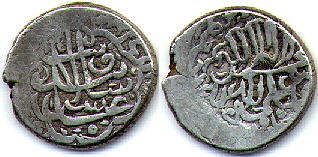
Silver Abbasi (4 Shahi), 22 mm.
Inscriptions both sides.
Struck 1578-1588 AD
Abbas I, regarded as one of the greatest Persian rulers, began his reign by ceding territory to his foes. He used the time he gained in doing so to create a standing army, the first in Persia. He ultimately won back the territory and expanded Persia's boundaries to the Indus in the east and to the Tigris in the west. From 1602 he campaigned against the Ottoman Turks, capturing Tabriz, Erivan, Shirvan, Baghdad, and Mosul. Abbas also restored internal order, promoted trade and the arts, and made his new capital at Isfahan one of the most beautiful cities in the world.
Asoka
Emperor of India, c. 272-232 BC
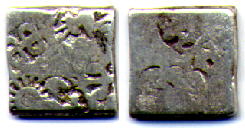
Three different silver Karshapanas, measuring (from left to right)
13 mm, 15 mm and 15 mm.
Each coin has on the obverse five individual punches:
Coin 1: ![]()
Coin 2:![]()
Coin 3:![]()
All Mauryan silver karshapanas show the first two symbols, the sun
and some form of the six-armed symbol. The third symbol, the "hills",
is thought the indicate the main mint at the time of Asoka. The fourth
symbol, composed of six semi-circles, is thought to represent the regal
symbol of Asoka. The fifth symbol is variable and may indicate a
particular coinage issue.
Asoka, one of the greatest emperors of India, made Buddhism the state religion of his realm. The third ruler of the Maurya dynasty, he enlarged his kingdom to include most of northern and central India as well as what are now Afghanistan and Baluchistan. After seeing the horrors of war, Asoka converted from Brahmanism to Buddhism and ruled according to Buddhist principles of philanthropy and compassion.
Chandragupta II
Emperor of India, c.380 - c.415 A.D.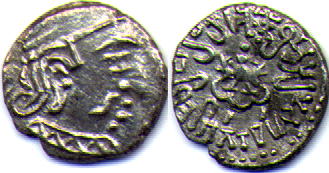
Silver, 14 mm
O: bust facing right.
R: Garuda, legend around. In Hindu mythology, Garuda was
a creature that was half man and half bird, and carried Vishnu wherever
he traveled.
The Gupta period is considered the golden age of ancient India. The Gupta empire reached its zenith under Chandragupta II, the third and most significant of the imperial Guptas.
Genghis Khan
Born c. 1167 A.D., "Universal Ruler" 1206-1227A.D.
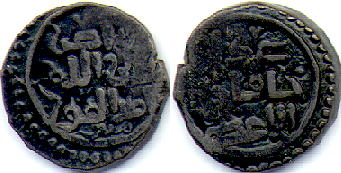
Jital of debased silver. 16 mm.
Ghazna mint.
C. 1220-1 A.D.
The great Mongol leader Genghis Khan was one of the great conquerors
in the history of the world. Named "Temujin" he was born to a leader
of a small tribe in northeastern Mongolia. His father was poisoned when
he was about 10 years old. In 1206, Temujin united the
warring Mongol tribes and was proclaimed Genghis Khan ("universal ruler")
of the Mongol chieftains. In 1207, Genghis Khan led the Mongols on
the first of the series of destructive, bloody invasions that would result
in the conquest of much of the Asian mainland, occupying Beijing (Peking)
in 1215. Extending their expeditions to the shores of the Caspian
Sea, the Mongol warriors penetrated the steppes of Russia and totally defeated
the Russian army by 1223. They did not, however, follow up their
victory with a conquest of the cities to the west; instead they returned
eastward. The empire established by Genghis Khan eventually extended
from the Pacific Ocean in the east to the Black Sea in the west.
Harun al-Rashid
Abbasid Caliph, 786 -809 AD
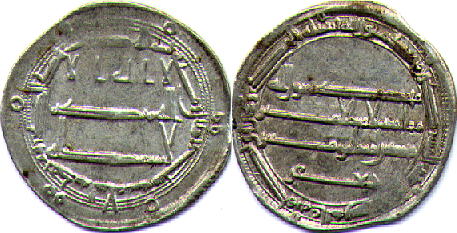
Silver Dirhem, Arabic inscriptions both sides.
Dated year 186 of the Hegira era (January 10, 802 to December 30, 802
AD)
Baghdad mint (written on the coin as "Madinat al-Salam", or "city of
peace")
Harun al-Rashid presided over the Abbasid Caliphate at its peak of
power. He is a legendary figure because of the splendor of his court,
and because of the stories about him in the Arabian Nights (1,001 Nights).
Baghdad, the capital of his reign, became the most flourishing city of the period. Tribute was paid to the caliph by many rulers, and splendid edifices were erected in his honor at enormous cost. He is said to have exchanged gifts with Charlemagne.
Before his death he divided the empire between his three sons, a step that accelerated its decline and disintegration.
Nadir Shah
Shah of Iran, 1736 - 1747 AD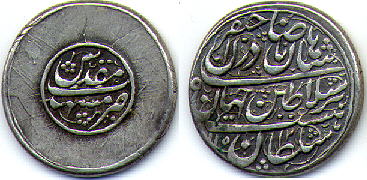
Silver Rupee, 25 mm.
Inscriptions both sides.
Meshed mint, dated 1152 AH = 1739-40 AD
One of the great Asian conquerors, Nadir Shah was the son of a chieftain of the Afshar, a Turkish tribe. A magnificent cavalry leader, he expelled the Afghan rulers and in 1732 placed Abbas III, the infant son of the last Safavid, on the throne with himself as regent.
In 1736, Nadir assumed the imperial title. He warred with virtually all neighboring states. In the west he defeated the Ottoman Turks and took Baghdad in 1733; in the north he repulsed Russia in the Caucasus; in the east he achieved spectacular success by invading India. He occupied Delhi and returned to Iran with marvelous booty that included the Koh-i-noor diamond and the Peacock Throne.
Nadir Shah was harsh, unskilled administrator who tolerated no opposition. Ultimately, disgruntled religious leaders and army officers succeeded in assassinating him in 1747.
al-Nasir Salah al-Din Yusuf I (Saladin)
Born c. 1138, Sultan of Egypt and Syria 1169-1193 A.D.
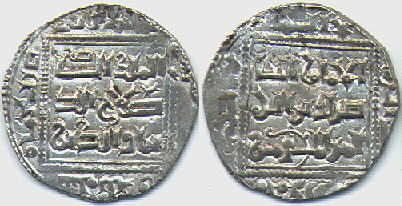
Silver Dirham, 21 mm.
Arabic inscriptions both sides.
Hamah Mint.
Dated 583 A.H. = c.1186 A.D.
Al-Nasir Salah al-Din Yusuf I, known as Saladin in the West, a Muslim warrior and founder of the Ayyubid dynasty, was a staunch opponent of the crusades. At the death (1174) of Nur Al-din, the Zangid ruler, Saladin set out to conquer the Zangid kingdom in Syria as a preliminary to the holy war (jihad) against the Crusaders. Launching the jihad in 1187, Saladin was victorious at Hattin, recaptured Jerusalem, and drove the Crusaders back to the coast. These events prompted the Christians to mount the Third Crusade (1189-92), pitting Saladin against Richard I of England. The Crusaders succeeded only in capturing Acre, and the Peace of Ramleh (1192) left the Latin Kingdom of Jerusalem with only a small strip of land along the Mediterranean coast. Saladin not only vanquished the Crusaders but also restored Egypt as the major power in the Middle East.
Suleiman I (Suleiman the Magnificent)
Sultan of the Ottoman Empire, 1520-1566 AD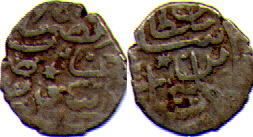
Silver Akche, 11 x 12 mm.
Inscription and star both sides.
Uskub Mint.
Dated 926 AH = 1520 AD, but coins were struck throughout Suleiman's
reign with this inaugural date but no actual date.
Ottoman sultan from 1520 to 1566, he brought the empire to its height
of power and grandeur, and its arts flourished. Suleiman succeeded
his father, Selim I, who left a throne with unprecedented wealth and power,
enabling Suleiman to consolidate and expand his holdings. He emphasized
fair systems of justice and taxation and a balanced budget, and was a preeminent
patron of the arts. He reformed the Ottoman legal system (he was
also known as the Lawgiver). Suleiman concentrated most, however,
on military campaigns, conquering Hungary and Mesopotamia (Iraq).
In his later years Suleiman withdrew from government participation,
and his three sons contested bitterly for the succession. The weakest of
these, Selim II (sultan 1566-74), succeeded, and the long Ottoman decline
began.
Timur ("Tamerlane")
Born 1336 A.D., died 1405 A.D.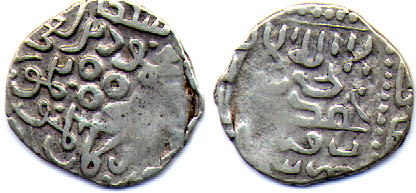
Silver 1/4 Tangka, 16 mm.
Samarqand mint, 1388-1403 AD
The three circles that figure prominently on the obverse represent the badge of Tamerlane.
The inscription names Tamerlane as subject to the Chagatayid overlord Mahmud. By this time, Tamerlane had usurped all effective power, but nonetheless continued to acknowledge the Chagatayid overlords in name.
Timur, or Tamerlane, a Mongol conqueror, claimed descent from Genghis Khan, and is regarded as his military equal. He was known in European circles as "Tamer the Lame" (he was wounded in battle and walked with a limp), hence the name "Tamerlane". Timur belonged to an Islamic Mongol tribe living in the area of Transoxiana (today's Uzbekistan). From his capital of Samarqand, Timur launched a career of expansion, with successful campaigns in Transcaucasia, Iran, Syria, Anatolia, and India. Timur died during a vain attempt to conquer China. Timur made no contribution to the governance or legal systems of the peoples he conquered. His cruelty went beyond that of any other Mongol khan or ruler -- he was responsible for the deaths of hundreds of thousands of people.
'Uthman
Caliph, 644 - 656 AD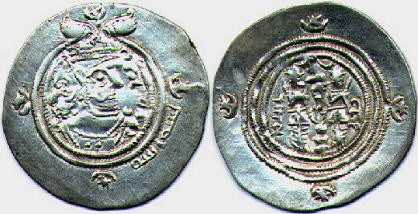
Silver Drachm, 31 mm.
Obverse: Head of Yezdigird III, the defeated Sassanian emperor. Legends in Pahlavi. In the margin, there is an Arabic inscription, "In the name of Allah"
Reverse: Fire Altar flanked by two attendants. Dated Year 20 of the reign of Yezdigird III.
The above is considered the first Islamic coin. It is copy of the final coin of the fallen Sassanian Empire, with the addition of the Arabic inscription to the margin on the obverse. These were first produced in 651 AD.
The Four Rashidun, or "Rightly-Guided" Caliphs were those rulers who came to power in the thirty years immediately following the death of the prophet Mohammad. The period of their rule is considered the golden age of Islam.
'Uthman was among Mohammad's first converts. He was elected the third caliph following the murder of 'Umar, and in preference to 'Ali. His rule was not well organized, and was troubled by disagreements concerning the division of the tremendous gains made in the Muslim conquests, as well as by conflict over the production and distribution of the definitive version of the Koran. A revolt led to his murder and 'Ali was proclaimed caliph. As part of the continuing battle over successesion, 'Ali was murdered a few years later by a breakaway group of his own followers, bringing the period of the Four Rashidun to an end.
The continuing struggle between the supporters of 'Uthman and those of 'Ali, known later as 'Alids or Shi'ites, produced profound effects on the history of Islam including the division into Sunni and Shi'ite sects which continues to this day.
Wu Ti
Born 156 B.C., Emperor of China, 140-87 B.C.
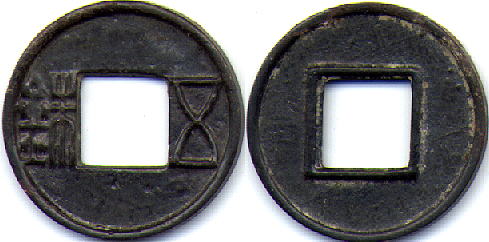
Copper, 25.5 mm.
O: Chinese inscription "Wu-Shu"
R: Blank.
In 118 BC., Wu Ti introduced these "Wu Shu" coins. These coins
were produced for more than seven hundred years, so it is generally difficult
to determine when a particular specimen was produced. However specific
details of the characters and the well-developed rims indicate that this
coin was among those produced during the reign of Wu Ti.
Han Wu Ti was the most illustrious emperor of the Han dynasty, bringing Han China to a peak of power, wealth, and cultural development. Even today the ethnic Chinese call themselves "Han," as distinct from the Manchus and other minorities in China. He ruled for over five decades, a period that saw great territorial expansion and a burst of economic and cultural activity. His armies pushed north and west into central Asia, east to Korea, and south to the coast. Trade with the states of western Asia grew, silk became a major export, and inventors found ways to make paper and porcelain. During his reign Confucianism became the state's orthodox philosophy; arts flourished, and the first systematic history of China was produced.
